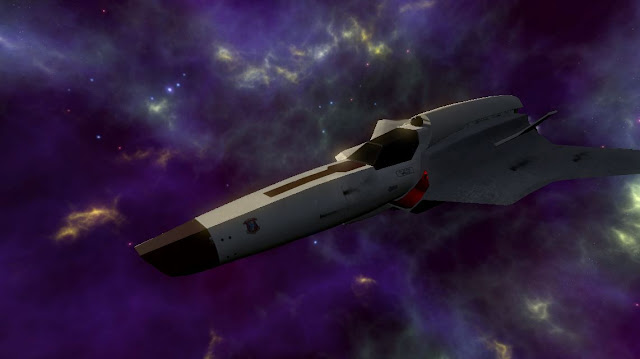I began laying out my UV's in preparation for X Normal. The fan blades were the first thing I baked onto my low poly, I created an ambient occlusion map and a normal map. Then pieced them together in Quixel. I also applied all of my materials using colour ID's in Quixel. This is the process I used for all the assets on my ship. Using 3DO I will paint decals and extra detail using paint layers, I will also use NDO to create extra detail on my normal maps.
 |
| Fan Blades in Quixel, textured using DDO. |
I had to create a cage to bake the main body of the ship. I did this to stop details from the high poly being baked onto the opposite side of the mesh.
Here is the final texture on the main body. I used the paint tools in 3DO to add all of the details. I got the decals from a fan made site detailing the creation of Battlestar Galactica.
 |
| Here is the UV layout of the cockpit. |
 |
| Here is the finished, textured version of the cockpit. I used colour IDs to separate the frame from the windows. |
Next I baked the jet fins down onto a low poly mesh. However there was a problem with the bake that I couldn't fix using X Normal. So I had to take the maps into Photoshop and fix them manually.
 |
| Problem area. |
Here you can see the part of the normal map causing the issue.
I fixed it by painting it out using a tablet. It was time consuming but definitely worth it.
I did this across the whole normal map.
The ambient occlusion also needed to be fixed.
 |
| Fixed normal map, broken AO map. |
I did the same thing with the AO that I did with the normal map and painted the problem areas.
Here you can see the end result. I then applied a material to the mesh in Quixel.
I carried on like this for the whole ship. However when I finished I realized there was a problem. I placed the ship into Unity with the materials and it became evident to me that I had too many materials for a single asset. I had 11 4k materials. While this created a great looking ship it was too much. So I began cutting the number of materials down by combining the meshes and materials together.
I combined the UV's and the materials down reducing the number of materials in Unity from 11 to 4.
Here is an example of one of the combined maps. I did this for the Albedo, AO, normal and specular. I have 3 other materials like this.





















































